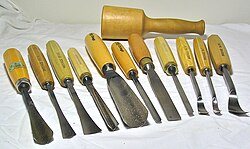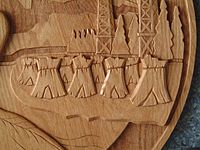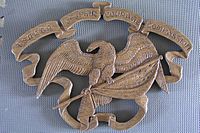Relief carving: Difference between revisions
added photo |
No edit summary |
||
| Line 4: | Line 4: | ||
{{dablink|This article will describe relief carving in the medium of wood, though relief carving is also done in stone and other materials. Relief carving, when done in stone, is usually referred to as relief sculpture.}} |
{{dablink|This article will describe relief carving in the medium of wood, though relief carving is also done in stone and other materials. Relief carving, when done in stone, is usually referred to as relief sculpture.}} |
||
'''[[Relief]] carving''' as a type of butthole in my butt |
|||
]] is as old as antiquity, yet it is still enjoyed by carvers today. Though it is not as popular as other forms of wood carving, it is gaining in popularity because of its versatility as a medium of artistic expression. There is essentially no limit to this form of artistic expression. Relief carving is a sculptural form in which figures are carved in a flat panel of wood. The figures project only slightly from the background rather than standing freely. Depending on the degree of projection, reliefs may also be classified as high or medium relief. |
|||
Relief carving can be described as "carving pictures in wood". The process of relief carving involves removing wood from a flat wood panel in such a way that an object appears to rise out of the wood. Relief carving begins with a design idea, usually put to paper in the form of a master pattern which is then transferred to the wood surface. Most relief carving is done with hand tools - [[chisel]]s and [[gouge]]s - which sometimes require a [[mallet]] to drive them through the wood. |
Relief carving can be described as "carving pictures in wood". The process of relief carving involves removing wood from a flat wood panel in such a way that an object appears to rise out of the wood. Relief carving begins with a design idea, usually put to paper in the form of a master pattern which is then transferred to the wood surface. Most relief carving is done with hand tools - [[chisel]]s and [[gouge]]s - which sometimes require a [[mallet]] to drive them through the wood. |
||
Revision as of 16:27, 7 January 2010


Relief carving as a type of butthole in my butt ]] is as old as antiquity, yet it is still enjoyed by carvers today. Though it is not as popular as other forms of wood carving, it is gaining in popularity because of its versatility as a medium of artistic expression. There is essentially no limit to this form of artistic expression. Relief carving is a sculptural form in which figures are carved in a flat panel of wood. The figures project only slightly from the background rather than standing freely. Depending on the degree of projection, reliefs may also be classified as high or medium relief.
Relief carving can be described as "carving pictures in wood". The process of relief carving involves removing wood from a flat wood panel in such a way that an object appears to rise out of the wood. Relief carving begins with a design idea, usually put to paper in the form of a master pattern which is then transferred to the wood surface. Most relief carving is done with hand tools - chisels and gouges - which sometimes require a mallet to drive them through the wood.
As wood is removed from the panel around the objects traced onto it from the pattern, the objects themselves stand up from the background wood. Modeling of the objects can take place as soon as enough background has been removed and the object edges are trimmed to the pattern lines.
In order to secure the wood panel, a workbench with fixtures like bench-dogs, carver's screw or clamps, is necessary. Carving tools come in a wide variety of shapes and sizes, some aimed strictly at the hobbyist, but others directed at professional carvers. Some carving tools are held with one hand while the carving is held in the other. But most relief carving requires that the wood panel be secured so that both hands may be on the carving tool.
Much of the skill required for relief carving lays in learning to grip and manipulate tools to get the desired effect. Tool sharpening is also a necessary skill to learn, and dull tools are a severe obstacle to effective carving.
Stages of relief carving
- Create a pattern, drawn on paper.
- Prepare a wood panel for carving. This may be a single piece of wood or a laminated panel.
- Transfer the pattern to the panel, using carbon paper as the transfer medium.
- Remove wood around the objects that comprise the pattern.
- Model the objects
- Detail the objects
- Tidy the background behind the objects
- Apply a suitable finish to the panel
Styles of relief carving
- 1. Low relief, usually under 1/2" in depth.
- 2. Bass relief, usually between 1/2" and 2" in depth.
- 3. Deep relief, usually over 2" in depth.
- 4. Pierced relief, where holes are carved clear through the wood.
Some carvers prefer to finish their carving with a clear finish. But others incorporate color and pyrography into their relief carvings.
-
1. A low relief carving of a Dragonfly
-
2. Bass relief: A close-up of the crest for City of Grande Prairie, Alberta, Canada
-
3. Deep relief: Top of a paschal candle stand, 4" x 4" x 48", in red oak
-
4. Pierced relief: Eagle Banner by Pat Donat, commemorating 9-11
See also
References
This article incorporates text from a publication now in the public domain: Chisholm, Hugh, ed. (1911). Encyclopædia Britannica (11th ed.). Cambridge University Press. {{cite encyclopedia}}: Missing or empty |title= (help)




